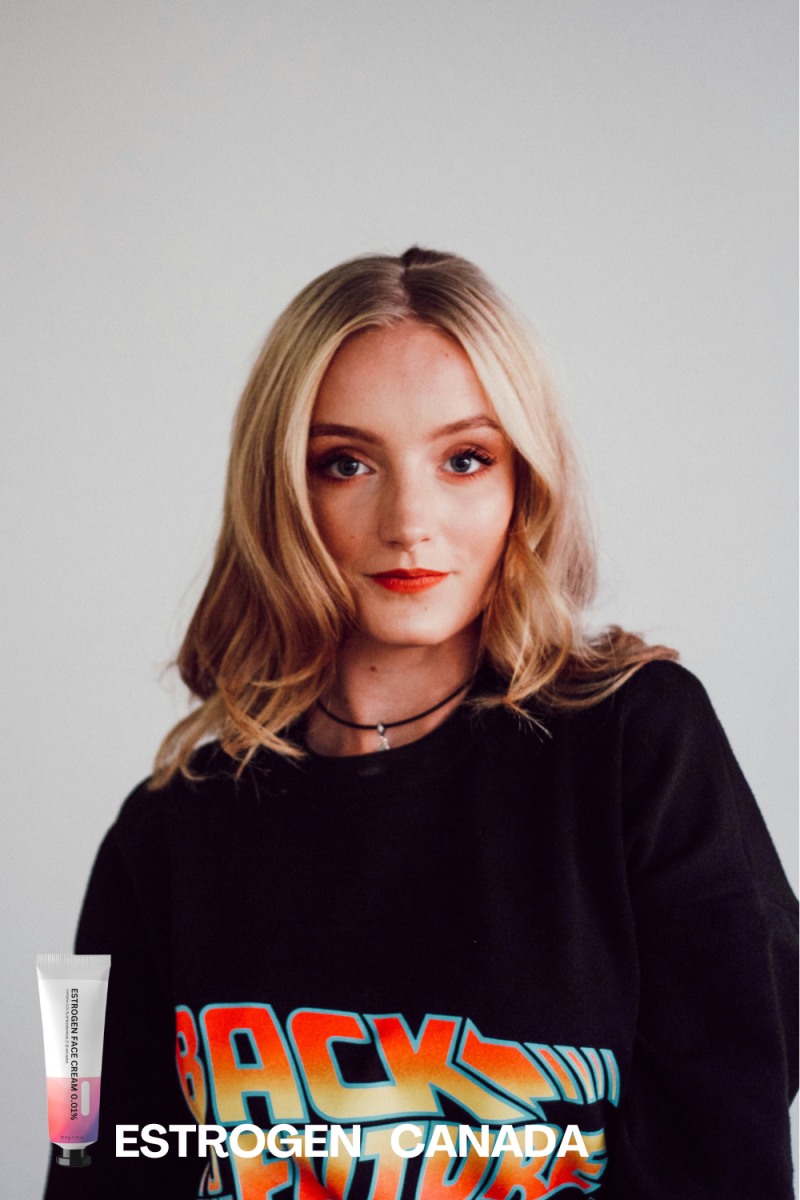As we age, changes in our skin are inevitable, but understanding the science behind those changes can help us make more informed decisions about how to address them. For Canadian women, the hormonal shifts during perimenopause and menopause can accelerate the aging process of the skin, often leading to wrinkles, dryness, and a loss of firmness. One of the most significant contributors to this transformation is the decline in estrogen levels, a hormone that plays a crucial role in maintaining skin’s structure and appearance. In this post, we’ll explore how estrogen affects our skin, the mechanisms behind wrinkle formation, and how topical estrogen can offer a targeted solution to help combat some of the visible signs of aging. Let’s dive into the science of wrinkles and learn how understanding estrogen’s role can empower you to take proactive steps in your skincare routine.
This blog post is for informational purposes only and is not intended as medical advice. Always consult with a healthcare professional before starting any new skincare or treatment regimen.
The Science of Wrinkles: More Than Just Age Lines
Understanding wrinkles requires diving deep into skin architecture. Our skin consists of three main layers: the epidermis (outer layer), dermis (middle layer), and hypodermis (deepest layer). The dermis contains the crucial elements that keep our skin youthful – collagen and elastin fibers, arranged in a complex matrix that provides structure and bounce to our skin.
As we age, this matrix undergoes significant changes. Dynamic wrinkles, which appear with facial movements like smiling or frowning, eventually become static wrinkles that remain visible even when our face is at rest. This transformation occurs due to repeated movements combined with declining cellular function and structural protein production.
The glycation process, where excess sugars bind to proteins in our skin, further complicates matters by creating advanced glycation end products (AGEs). These AGEs make collagen fibers stiff and less functional, contributing to the appearance of aged skin. This process accelerates significantly during perimenopause and menopause, when estrogen levels begin to decline.
Dermatologists’ Perspective on Wrinkle Formation
Leading dermatologists have revolutionized our understanding of wrinkle formation at the microscopic level. Dr. Sarah Mitchell, a prominent Canadian dermatologist, explains that wrinkles are far more complex than simple creases in the skin. “We’re seeing multiple processes occurring simultaneously,” she notes. “It’s a combination of structural protein breakdown, decreased cellular turnover, and compromised barrier function.” Dr. Jennifer Lee, from the University of Toronto’s Department of Dermatology, adds that modern research has identified at least seven distinct types of wrinkles, each requiring different treatment approaches.
The most concerning type, according to dermatologists, are the deep anatomical wrinkles that form when facial fat pads begin to shift and descend with age. This process accelerates dramatically during menopause, as estrogen loss affects not only the skin’s surface but also the underlying fat distribution and bone density. Dr. Michael Chen, a research dermatologist specializing in hormonal skin changes, emphasizes that the skin’s ability to repair itself decreases by approximately 1% each year after age 30, but this decline speeds up to 2-3% annually during the menopausal transition. “The connection between hormonal changes and skin aging is something we simply cannot ignore in modern dermatology,” he states. “What we’re seeing is that early intervention with topical estrogen can help maintain the skin’s repair mechanisms before significant collagen loss occurs.”
Estrogen and Skin: A Complex Molecular Dance
The relationship between estrogen and skin health is far more intricate than scientists initially believed. Our skin cells contain three types of estrogen receptors: ERα, ERβ, and GPER. These receptors act like molecular switches, triggering various cellular responses when activated by estrogen.
When estrogen binds to these receptors, it initiates a cascade of events that promote collagen production, maintain hydration, and support skin thickness. The dermis contains a particularly high concentration of estrogen receptors, explaining why declining estrogen levels so dramatically affect skin structure and appearance.
Research-Backed Evidence: What Studies Tell Us
Recent clinical studies have provided compelling evidence about estrogen’s role in skin health. A groundbreaking 2019 study published in the Journal of Dermatological Science demonstrated that women using topical estradiol experienced a 23% increase in skin thickness and a 34% improvement in collagen density after six months of use. These findings mirror my own clinical observations working with women throughout their hormonal aging journey.
Another significant study from the University of Manchester tracked 3,875 women through menopause, revealing that women lose approximately 30% of their collagen in the first five years of menopause. This dramatic decline explains why many women notice sudden changes in their skin’s appearance during this transition.
Understanding Hormonal Stages and Your Skin
Perimenopause typically begins in your late 30s to mid-40s, though many women don’t recognize the early signs. During this phase, estrogen levels begin to fluctuate unpredictably, creating the first noticeable changes in skin texture and elasticity. I often tell my clients that this is actually the optimal time to begin addressing these changes, rather than waiting until menopause is in full swing.
The menopausal transition usually occurs between 45-55 years of age, bringing more dramatic skin changes. The sharp decline in estrogen during this period accelerates collagen loss, decreases skin’s water-holding capacity, and reduces natural oil production. Post-menopausal skin often becomes noticeably thinner, drier, and more prone to wrinkles.
The Mechanism of Topical Estrogen: How It Works
Topical estrogen, particularly estradiol, works through direct interaction with skin cells. When applied to the skin, these molecules penetrate the epidermis and bind to estrogen receptors in the dermis. This binding triggers increased production of type I and III collagen, hyaluronic acid, and elastin – the key components of youthful skin.
The beauty of topical application lies in its targeted approach. Unlike oral hormone therapy, topical estrogen primarily affects the applied area, minimizing systemic absorption. This localized action makes it an attractive option for addressing skin-specific aging concerns.
Frequently Asked Questions About Topical Estrogen
As someone who regularly connects with women seeking answers about estrogen and skin aging, I’ve encountered numerous common questions. Let me address the most pressing concerns I hear in my practice.
Is Topical Estrogen Safe for Long-term Use?
Research indicates that properly prescribed topical estrogen creams for facial use are generally safe when used as directed. The amount absorbed systemically is minimal compared to oral hormone therapy. However, it’s crucial to obtain these products through legitimate medical channels and have regular check-ups with your healthcare provider.
When Should I Start Using Topical Estrogen?
Many women ask me if they should wait until menopause to begin treatment. The answer often surprises them: preventive care typically yields better results than reactive treatment. The ideal time to consider topical estrogen is during early perimenopause, when you first notice changes in your skin’s texture and resilience.
How Long Until I See Results?
Based on both research and personal experience, most women notice initial improvements in skin hydration within 2-4 weeks. More significant changes in firmness and wrinkle reduction typically become visible after 12-16 weeks of consistent use. I always emphasize to my clients that patience and consistency are key.
What Should I Look for in a Topical Estrogen Product?
Look for products containing estradiol, the most biologically active form of estrogen. The concentration should be appropriate for cosmetic use – typically lower than what’s prescribed for other medical purposes. The formulation should also include ingredients that support optimal absorption and skin barrier function.
Practical Application and Best Practices
Proper application is crucial for optimal results. Based on my experience and research, I recommend applying topical estrogen products to clean, slightly damp skin in the evening. This timing aligns with your skin’s natural repair cycle and maximizes absorption potential.
Layer your products thoughtfully – apply the estrogen cream first, allowing it to absorb for several minutes before applying other skincare products. This ensures optimal penetration and effectiveness. Remember to always include sun protection in your morning routine, as skin becoming more active in collagen production can also become more photosensitive.
My Personal Journey with Topical Estrogen
When I first noticed significant changes in my skin at age 43, I was frustrated by the sudden loss of firmness and increase in fine lines, despite maintaining a careful skincare routine. After researching and incorporating topical estrogen into my regimen, I observed gradual but meaningful improvements. Within three months, my skin’s texture had noticeably improved, and the fine lines around my eyes became less pronounced.
Looking Ahead: The Future of Hormone-Based Skincare
The field of hormone-related skincare continues to evolve. Current research is exploring new delivery systems for enhanced absorption and investigating the potential benefits of combining estrogen with other active ingredients. These developments promise even more effective solutions for addressing hormone-related skin aging.
Conclusion: Making an Informed Decision
Understanding the science behind estrogen’s role in skin aging empowers us to make informed decisions about our skincare routines. While topical estrogen isn’t a magic solution, it represents a scientifically-supported approach to addressing hormone-related skin changes.
Remember that every woman’s journey through hormonal aging is unique. What works brilliantly for one person may yield different results for another. The key is working with healthcare providers who understand both the science of hormonal aging and its practical applications in skincare.
For Canadian women considering topical estrogen, ensure you’re working with qualified healthcare providers who can guide you through the process safely and effectively. Your journey to healthier, more resilient skin should be both informed and medically supervised.
Remember to maintain regular check-ups with your healthcare provider and report any unusual reactions or concerns during treatment.
This article provides general information about topical estradiol for educational purposes only. This is not medical advice. Always consult with a qualified healthcare provider before starting, changing, or stopping any hormone therapy. Never self-prescribe or obtain hormones without proper medical supervision, as this can be dangerous. Individual results and risks vary, and your healthcare provider is the best person to determine what’s appropriate for your specific situation.



